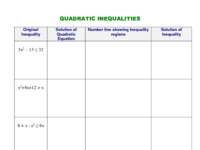Lesson 3 Quadratic Inequalities part i
A note about prior knowledge
The ability to solve a quadratic equation is not a pre-requisite for this activity, in part ii, a quadratic solver is available for those who do not know how to factorise, or prefer to use the quadratic formula.
Students should plot the graphs of two functions, where applicable, therefore there is no requirement to rearrange equations in part i, but there is an opportunity to do this, if the student wishes in part ii.
Starter: The equation of a straight line
The general equation of a straight line is where is the gradient, and the y-intercept.
The gradient can be calculated using , ( means change) it describes how steep the slope of the line is, that is how much the output (y-value) increases, or decreases by, as a result of increasing the input (x-value) by 1.
The y-intercept is the y-coordinate of the point where the line meets the y-axis.
Practice plotting a few straight lines using the tool below. Press the button to check if you are correct. Move on when you are happy
Example
It is possible to draw comparisons between two functions, where one of them is a quadratic by plotting both of the functions, as we saw in lesson two.
If we wanted to find the set of solutions for which <
We will use the plotting tool to plot the graphs of and
We can see that the blue function is less than the green function for values of between -4 and 0.
Try to imagine your -axis as a number line, we could represent the inequality on there like this:

 It is possible to represent this set of solutions using either inequality of interval notation as seen in lesson one. So we could write the set of solutions to this inequality as -4 < < 0.
Similarly, if we were to write the set of solutions for which > , this would either be when
< -4 or when > 0
It is possible to represent this set of solutions using either inequality of interval notation as seen in lesson one. So we could write the set of solutions to this inequality as -4 < < 0.
Similarly, if we were to write the set of solutions for which > , this would either be when
< -4 or when > 0
Task
Complete the questions on the worksheet below, using the plotting tool to help. Do a sketch of the number line, and write down the set of solutions to solve each inequality
